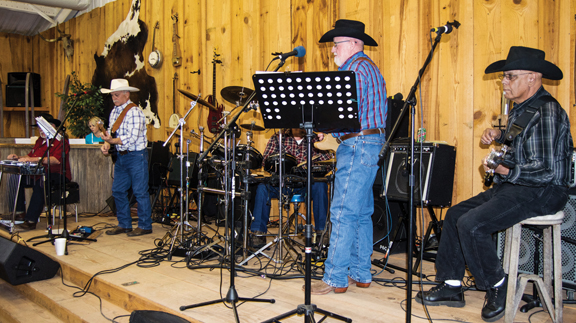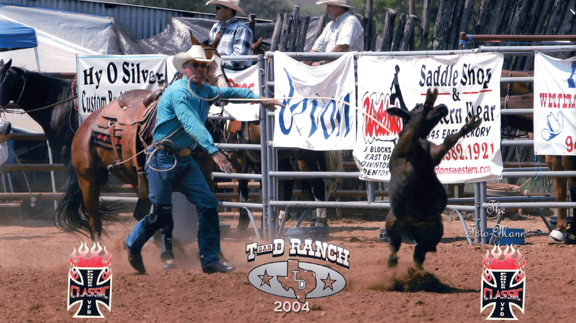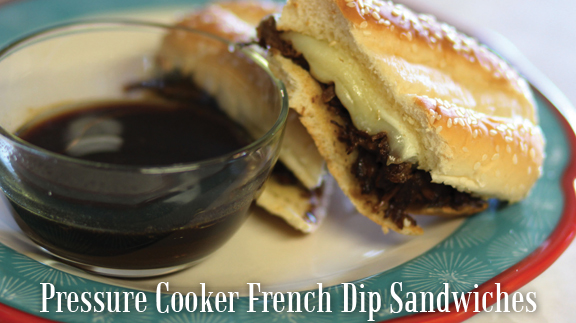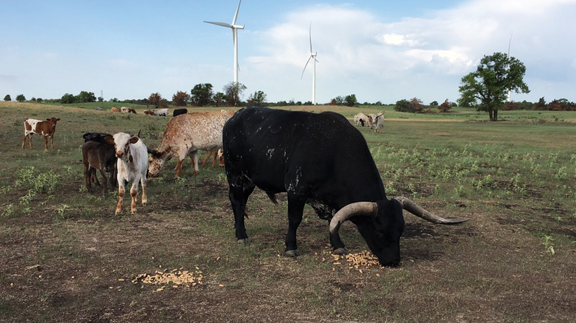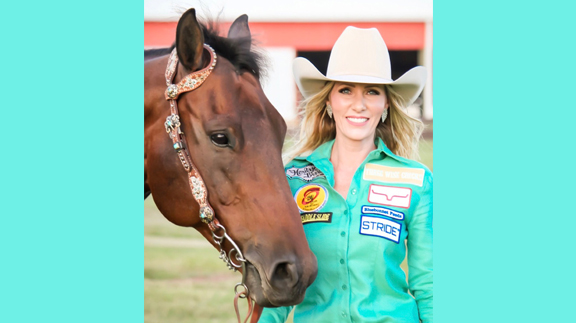Country Lifestyle
ONLINE EXCLUSIVE: Team Roping Benefits the Community
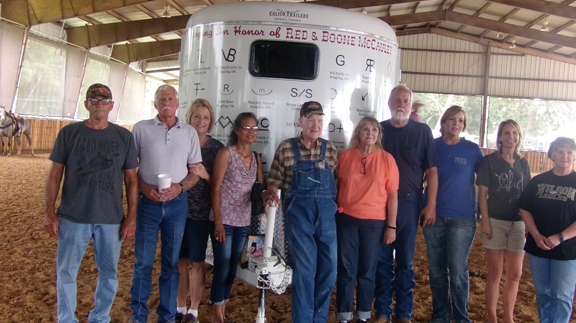
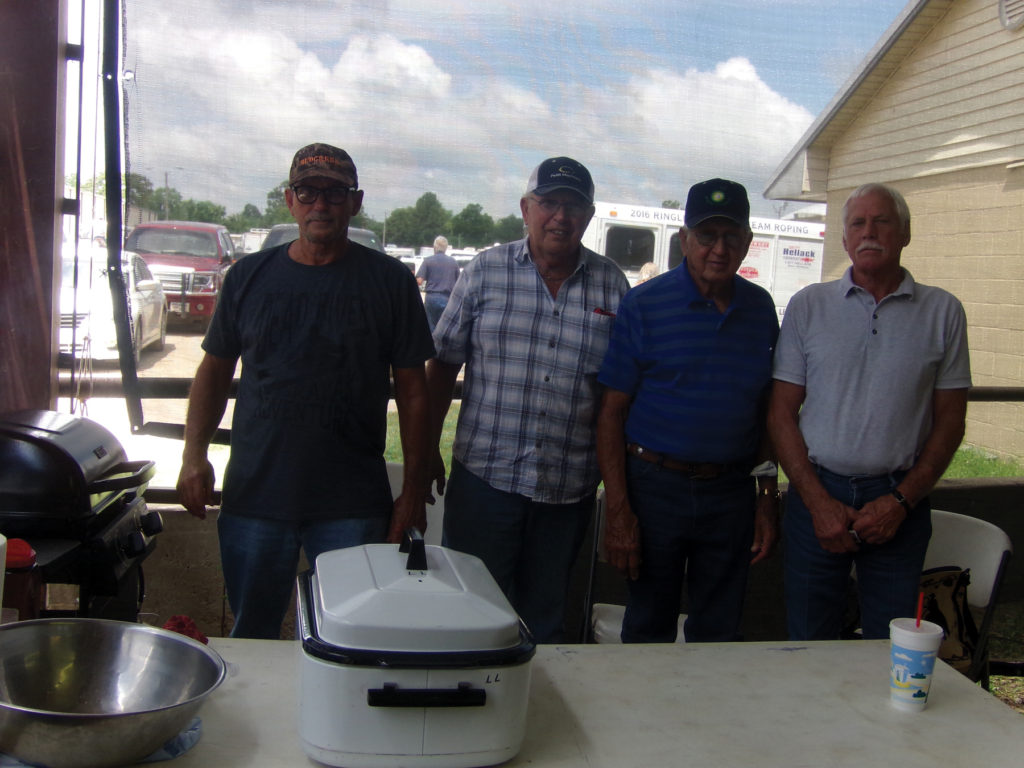
Bill Fincher (left), Harold Allen, Sherle Lockwood and Bob Earl Stewart cooking burgers. Photo by Judy Wade.
By Judy Wade
The 11th annual Ringling Community Benefit Team Roping kicked off at 10 a.m. Saturday, June 4 in arena two at Hardy Murphy Coliseum in Ardmore, Okla.
“In the first 10 years, we raised between $250,000 and $300,000 that has been given back to the community,” according to Lyndal Van Buskirk. The team roping has moved from its original home at the Mountain Home arena north of Ringling, Okla., to the Ardmore facility the past two years because of rain.
Its inaugural year, 2005, was to assist a young woman in Ringling who had been diagnosed with cancer. The roping has continued to grow and last year provided over $29,000 to a number of organizations and individuals in the area. Some of those benefiting include Ringling, Orr, Claypool, Loco and Courtney Volunteer Fire Departments, The Senior Citizens’ Center, Ringling FFA, the Food Bank, youngsters needing winter coats and school supplies and individuals with health problems or whose homes have burned. Recipients vary from year to year, depending on need.
This team roping is popular with contestants because of the good prize money (70 percent of the entry fees is paid back to winners), two horse trailers that go to the high point individuals of each roping and numerous other prizes.
Businesses pay a fee to have their advertisement on the trailers, and area ranchers can have their brands placed on it. This year one trailer honored Red and Boone McCauley and the other Tom and Donna Hildebrandt and Mike and Kay Moore. Those honored or a family member also receive belt buckles.
A committee of area business persons and ranchers decide in whose names the trailers will be given and who is to benefit from the proceeds. This year’s committee members include Lyndal, Janet, Frank and Susan Van Buskirk; Sherle, Charley and Nikki Lockwood; Terry and Terral McLemore; Shelley Lewis, Londa Pogue, Harold Allen, Bob Earl Stewart, Bill Fincher and Stacey Clough.
Also serving are Dustin Weatherly, Johnny Dewbre, Karla Pickens, Sherry and Rusty Mashore, Joe Roberts and Tracey Rapier.
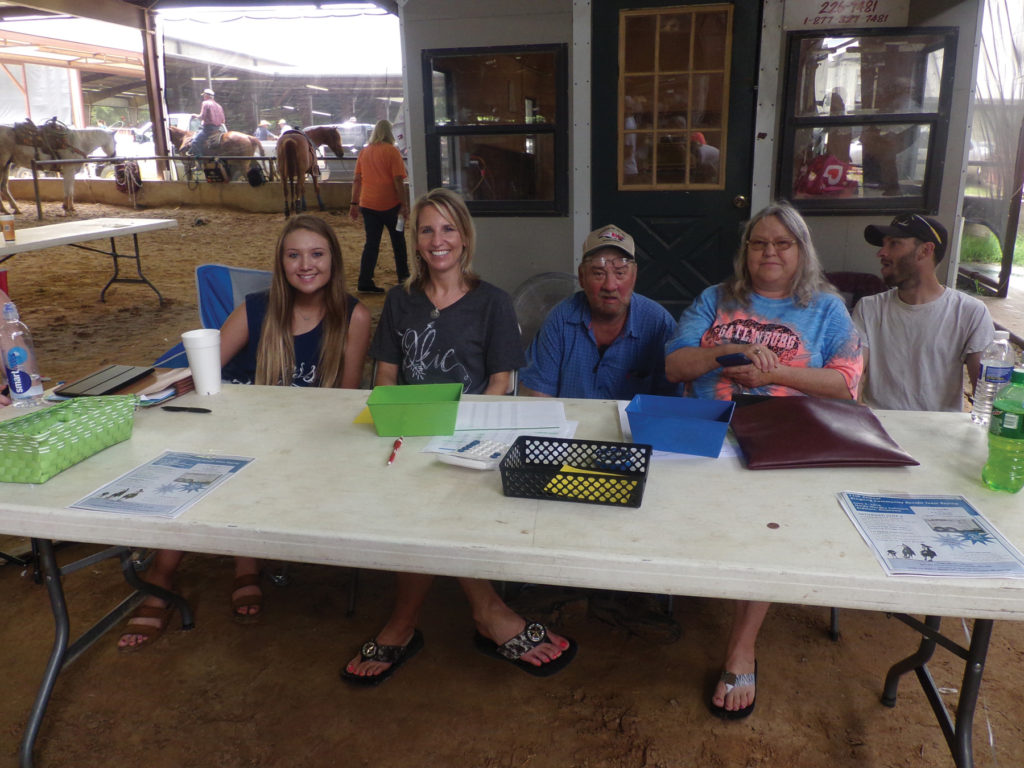
Brinlee Dulaney (left), Susan Van Buskirk and Darlene Crowell take entries while Bill and Rodney Crowell look on. Photo by Judy Wade.
It takes an immense number of volunteers to make the roping a success.
Some take entries and keep the books, others cook hamburgers, Ringling FFA members run the concession stand and about 20 work the chute and keep the cattle ready. Area merchants donate much of the supplies for the concession stand, but there are expenses.
“The only things we have to pay for are the cattle, the facility, announcer, time keepers and flagman,” Janet Van Buskirk explained. “All the rest is run by volunteers.”
This year, 313 teams entered the number 13 with a total payback of $21,500. The top 25 came back to the short go, with Shawn Scott and Kolby Miller emerging as the winners, splitting $5,400 for first place. Miller also placed sixth for another $650, giving him the most points and making him the trailer winner. Prize money was paid through eighth place, and points for the trailer were given through 20th place. Two places were also paid in the number eleven incentive.
In the number eight roping, 247 roped for $16,000 in prize money. Winners Chris Nance and Dustin Hatley split $3,400. Fernando Selgado placed second and sixth and won the No. 8 incentive, a total of $2,750, and the most points to claim the second trailer.
About two weeks after the roping, the committee meet, critique the roping, address any problem areas and begin to plan for next year.
“So far we have not had any problems,” Van Buskirk said.
Bill and Darlene Crowell have been supporters of the roping from the beginning, with Darlene taking entries and Bill helping where needed and entering the roping. In fact, Bill won the first saddle given away at the event years ago.
“What started out as a benefit for one cancer patient has turned into a community benefit helping a lot of people,” the Crowells said.
The event is a team effort, Janet added.
“We can’t give enough money to one person to pay all their medical bills, but we can help get them to and from treatments,” Van Buskirk said.
It has become an event that continues to assist a wide range of people in the Ringling area, living up to its name, the Ringling Community Benefit Team Roping.
Country Lifestyle
Poinsettia Partnerships Will Make Your Holidays Beautiful

By
Norman Winter
Horticulturist, Author and Speaker
National Poinsettia Day just passed, December 12 to be exact. While I am sure the powers to be wanted a celebratory type day, from what I have been seeing this year is this may have been a deadline day. This most likely applies to poinsettia partners too! If you are asking what a poinsettia partner is then put on your thinking cap and gather around.
Proven Winners got most of us to thinking partners when they introduced the concept of combining poinsettias with Diamond Frost euphorbias. This is one of the best ideas ever and we now actually have three choices, Diamond Frost, Diamond Snow with double flowers and Diamond Mountain that is the taller of the three.
To a horticulturist like myself this combination is so special because both the Poinsettia and the Diamond Frost are Euphorbias. That’s right, they are cousins. Just like Christmas, families visiting and long-lost cousins getting together. Of course, the main reason we like this idea is that the red, pink, or variegated poinsettia looks incredible, it’s as though it is sitting on a bed of snow or frost. I have found these to be more available at fine florists.
But if you are going to create your own and go plant shopping then keep in mind some other options you might want to-try. For instance, a couple of years ago Jenny Simpson of Creekside Nursery in Dallas North Carolina introduced us to not only using caladiums at Christmas but even in combinations with poinsettias. She used the Heart to Heart White Snowdrift caladiums which turned out to be a perfect partner with red poinsettias.
My time as Executive Director at the Coastal Georgia Botanical Gardens in Savannah GA taught me there are opportunities for outside use with poinsettias, particularly if you are astute at long range weather forecasting. First consider that Savannah is technically zone 8B with a proclivity to lean into zone 9. We used poinsettias in large planters surrounded by Silver Bullet Dusty Miller or artemisia.
A similar application gave me the opportunity of photographing pink poinsettias mass planted in an atrium-like setting and surrounded by gray leaved Icicles helichrysum. But the most obvious and perhaps easiest if you are getting a late start is to combine your poinsettias with another Christmas plant like cyclamen. White cyclamen around a red poinsettia can be simply breathtaking.
This year I have also been watching what I call the professional garden club ladies walking out of both florists and floral departments with holly berries. We all think of hollies on swags above the fireplace or front door, but two or three preserved branches loaded with red berries stuck in a pot of white poinsettias is quick, easy and unbeatable.
Red berries for Christmas, landscape beauty, and of course feeding the birds is a prime reason to grow winterberry hollies like the compact Berry Poppins. Consider also growing Berry Heavy Gold winterberry holly. Cutting branches of the gold berries to be used with red poinsettias makes a stunning partnership. Go to Proven Winners site, Winterberry Holly: The Ultimate Guide to Getting Colorful Berries. If you don’t have poinsettias yet make today your shopping day! Follow me on Facebook @NormanWinterTheGardenGuy for more photos and garden inspiration.
Country Lifestyle
Homesteading Skills: The Essentials for Self-Sufficiency and Sustainable Living
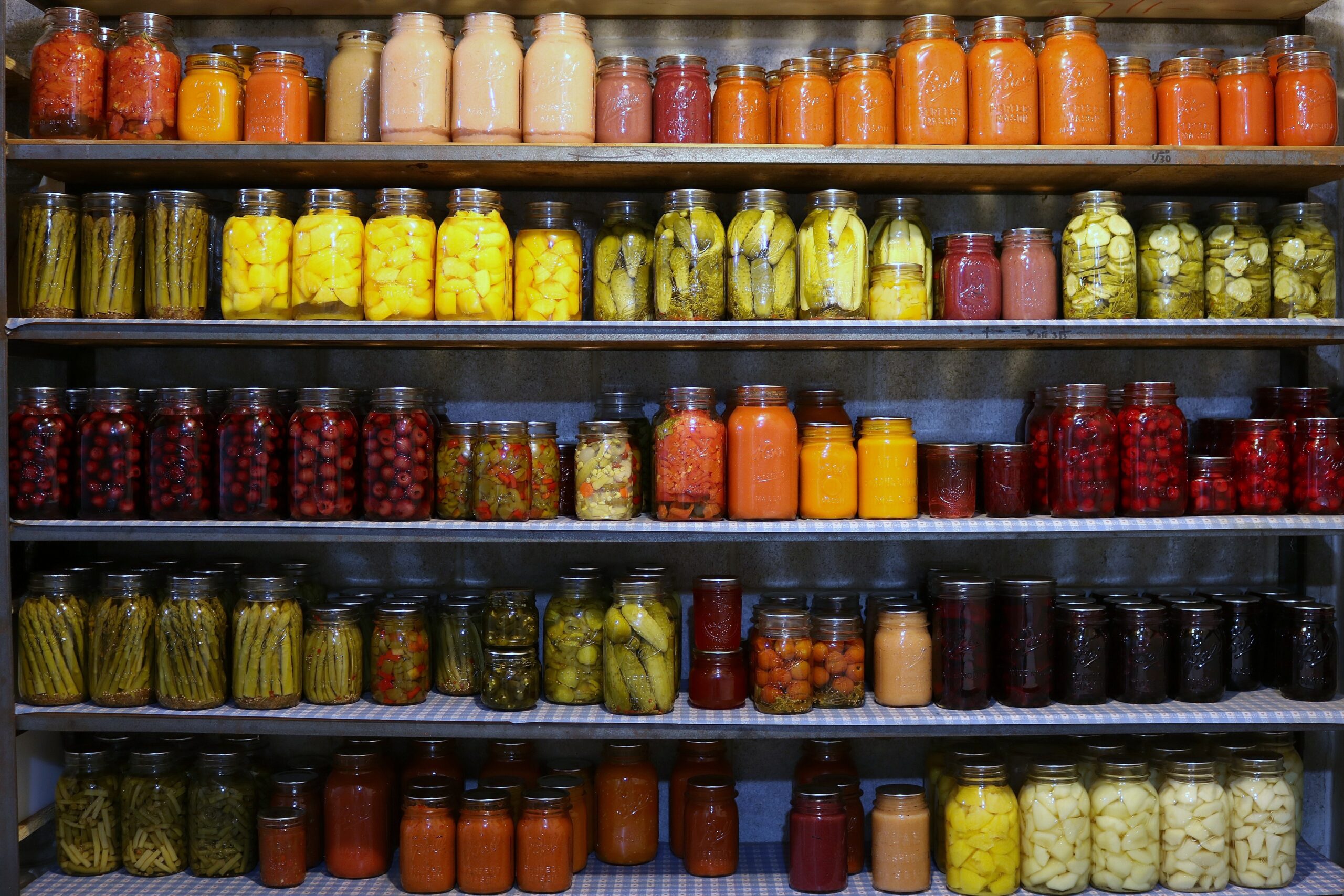
Homesteading, once a way of life for our ancestors, is experiencing a resurgence in today’s world. As people seek greater self-sufficiency, a deeper connection with the land, and more sustainable lifestyles, homesteading skills have become not only practical but also deeply rewarding. In this article, we’ll explore the essential homesteading skills that can empower individuals and families to live more self-reliant and sustainable lives.
1. Gardening
At the heart of homesteading is the ability to grow your own food. Gardening is the foundation of self-sufficiency, and it’s a skill that can be cultivated no matter the size of your property. Key gardening skills include:
Soil preparation and composting
Seed starting and transplanting
Crop rotation and companion planting
Pest and weed management
Harvesting and food preservation techniques like canning, freezing, and drying
2. Animal Husbandry
Raising animals for food, fiber, and companionship is a fundamental aspect of homesteading. The skills related to animal husbandry include:
Care and feeding of livestock, such as chickens, goats, cows, or pigs
Breeding and reproduction management
Livestock housing and pasture management
Animal health and basic veterinary care
Dairy and meat processing if you’re raising animals for consumption
3. Food Preservation
To make the most of your garden’s bounty or the harvest from your livestock, knowing how to preserve food is essential. Food preservation skills include:
Canning fruits and vegetables
Fermentation for foods like sauerkraut and kimchi
Dehydrating fruits, vegetables, and herbs
Making homemade jams, jellies, and pickles
Smoking, curing, and other methods for meat preservation
4. Foraging and Wildcrafting
Homesteading often involves making the most of what nature provides. Learning to identify and use wild edibles and medicinals is a valuable skill:
Identifying edible wild plants and mushrooms
Harvesting herbs for teas, tinctures, and salves
Sustainable foraging practices to protect local ecosystems
Preserving wildcrafted items for later use
5. Beekeeping
Keeping bees not only provides a source of honey but also contributes to pollination on your property. Beekeeping skills include:
Setting up and maintaining beehives
Handling and managing bees safely
Harvesting and processing honey and beeswax
Identifying and addressing common bee health issues
6. Food Self-Sufficiency
Beyond gardening, you can work toward greater food self-sufficiency by learning skills like:
Seed saving to preserve heirloom and open-pollinated varieties
Raising and harvesting small livestock like rabbits or quail
Cultivating perennial food crops like fruit trees and berry bushes
Aquaponics or hydroponics for year-round food production
7. Basic Carpentry and DIY Skills
Homesteaders often find themselves needing to build and repair structures, tools, and equipment. Carpentry and DIY skills include:
Building raised beds, chicken coops, and animal shelters
Basic woodworking for constructing furniture and farm implements
Repairing and maintaining machinery like tractors and generators
Fencing and infrastructure construction for property management
8. Water Management
Managing water resources efficiently is crucial for sustainable living. Key skills include:
Rainwater harvesting and storage
Drip irrigation and water-saving techniques for gardening
Proper well maintenance and water testing
Building and maintaining ponds or water features for livestock and wildlife
9. Energy Independence
To live off the grid or reduce your environmental footprint, consider energy independence skills:
Solar panel installation and maintenance
Wind turbine installation and maintenance
Energy-efficient building design and retrofits
Off-grid living strategies for reduced reliance on public utilities
10. Soap and Candle Making
Homemade soaps and candles can reduce reliance on store-bought products. These skills include:
Making soap using cold or hot process methods
Crafting candles from beeswax, soy, or other materials
Adding scents and colors naturally
11. Herbal Medicine and Remedies
Homesteaders often turn to herbal medicine and remedies for self-sufficiency in healthcare:
Growing and harvesting medicinal herbs
Making tinctures, salves, and herbal teas
Natural remedies for common ailments
Basic first-aid and emergency care skills
12. Sewing and Textile Arts
Basic sewing skills are essential for making and repairing clothing, linens, and more. These skills include:
Hand and machine sewing techniques
Mending and darning clothing
Knitting, crocheting, and other textile arts
Crafting items like blankets, rugs, and quilts
Homesteading is not just a return to simpler times but a way to embrace self-sufficiency, sustainability, and a deeper connection with the land. While mastering all these skills may take time, the journey itself is a rich and rewarding experience. Homesteading is about learning, adapting, and continually improving your ability to live more independently and in harmony with the environment. Whether you have acres of land or a small urban plot, these essential homesteading skills can empower you to live a more self-reliant and sustainable life, fostering a sense of fulfillment and purpose in the process.
Country Lifestyle
Raising Chickens for Beginners: A Step-by-Step Guide
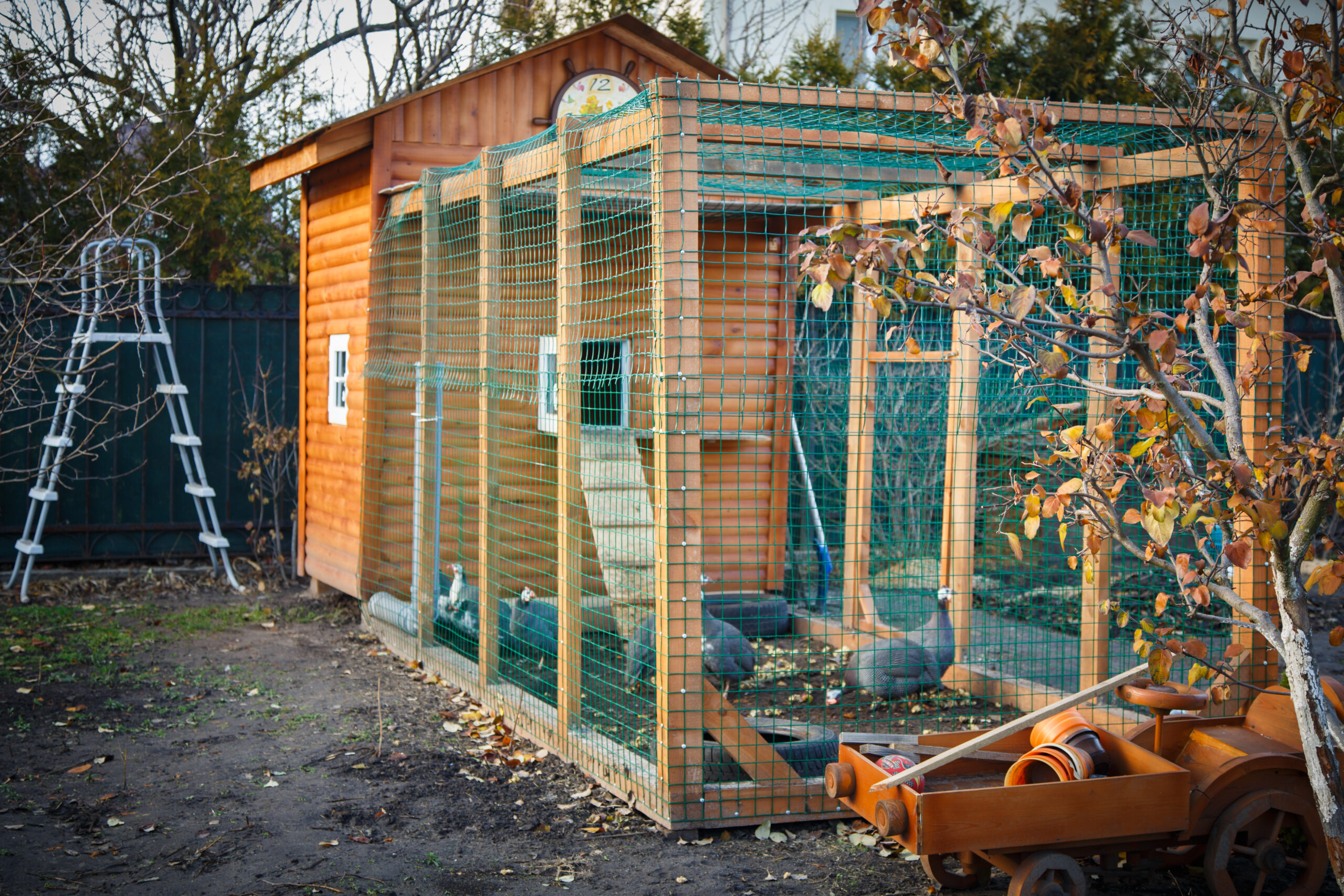
Raising chickens can be a rewarding and fulfilling experience, whether you’re a homesteader looking to become more self-sufficient or a backyard enthusiast seeking fresh eggs for your family. Chickens are relatively low-maintenance animals, making them an excellent choice for beginners in the world of poultry farming. In this step-by-step guide, we will walk you through the essentials of raising chickens, from choosing the right breed to ensuring their health and happiness.
Selecting the Right Breed
Before diving into chicken-raising, it’s crucial to choose the right breed that suits your goals and environment. Different breeds have various characteristics, including egg-laying capacity, temperament, and adaptability. Here are some popular options for beginners:
Rhode Island Red: Known for their excellent egg production and hardiness.
Plymouth Rock: Friendly birds that lay brown eggs and adapt well to various climates.
Australorp: Record-holders for egg-laying, known for their docile nature.
Silkies: Unique and fluffy birds often kept as pets; they lay smaller eggs but are adorable companions.
Research the specific breeds available in your area and consider factors like climate and available space when making your selection.
Coop and Run Setup
Before bringing your chickens home, you’ll need to set up a safe and comfortable living space for them. A coop and run are essential components of your chicken-keeping setup:
Coop: The coop is where your chickens will sleep at night and lay their eggs. It should be well-insulated, predator-proof, and provide at least two to three square feet of space per chicken.
Run: The run is an outdoor area where your chickens can roam during the day. It should be fenced and covered to protect your birds from predators and provide shade.
Make sure to include roosting bars, nesting boxes, and adequate ventilation in your coop for a healthy environment.
Feeding Your Chickens
Chickens need a balanced diet to stay healthy and lay eggs regularly. You can feed them commercial chicken feed, which comes in various forms:
Starter Feed: For chicks up to six weeks old.
Grower Feed: For chicks aged six weeks to 20 weeks.
Layer Feed: For hens producing eggs.
Additionally, you can supplement their diet with kitchen scraps, vegetables, and grains. Ensure they have access to clean, fresh water at all times.
Care and Health
Regular care and monitoring are essential to keeping your chickens healthy. Here are some key aspects of chicken care:
Regular Health Checks: Inspect your chickens for signs of illness or injury daily. Common issues include mites, respiratory infections, and injuries from pecking.
Disease Prevention: Vaccinate your chickens against common diseases to keep your flock healthy.
Egg Collection: Collect eggs daily to ensure they remain clean and prevent hens from brooding.
Clean Coop: Regularly clean the coop to prevent the buildup of waste and odors, which can attract pests.
Handling and Socializing
Chickens can be friendly and enjoy human interaction when handled gently. Spend time with your chickens, hand-feeding them treats to build trust. Avoid sudden movements or loud noises, which can startle them.
Understanding Egg Production
Egg production varies by breed and age. Hens typically start laying eggs at around 5-6 months old. The amount of daylight, diet, and stress can affect egg production. You can use artificial lighting to simulate longer daylight hours, which can encourage consistent egg-laying.
Dealing with Challenges
Chickens, like any animal, come with their challenges. Here are a few common issues and how to address them:
Predators: Invest in a secure coop and run, and consider adding motion-activated lights or alarms to deter nighttime predators.
Broodiness: Some hens may become broody and stop laying eggs. You can break this behavior by isolating them in a separate enclosure or providing them with dummy eggs to sit on.
Feather Pecking: Chickens can sometimes develop a habit of pecking at each other’s feathers. Ensure they have enough space and distractions to prevent this behavior.
Raising chickens can be a delightful and educational journey. By selecting the right breed, setting up a proper coop and run, providing a balanced diet, and offering care and attention, you can enjoy the rewards of fresh eggs and the companionship of these feathered friends. Remember that every chicken has its unique personality, so get ready to be charmed by your new flock as you embark on this fulfilling adventure in poultry farming. Happy chicken-keeping!
-

 Country Lifestyle7 years ago
Country Lifestyle7 years agoJuly 2017 Profile: J.W. Hart
-

 Outdoors6 years ago
Outdoors6 years agoGrazing Oklahoma: Honey Locust
-

 Country Lifestyle2 years ago
Country Lifestyle2 years agoThe Two Sides of Colten Jesse
-

 Attractions7 years ago
Attractions7 years ago48 Hours in Atoka Remembered
-

 Farm & Ranch5 years ago
Farm & Ranch5 years agoHackberry (Celtis spp.)
-

 Outdoors4 years ago
Outdoors4 years agoPecan Production Information: Online Resources for Growers
-

 Equine6 years ago
Equine6 years agoUmbilical Hernia
-

 Country Lifestyle1 year ago
Country Lifestyle1 year agoSay Yes!

